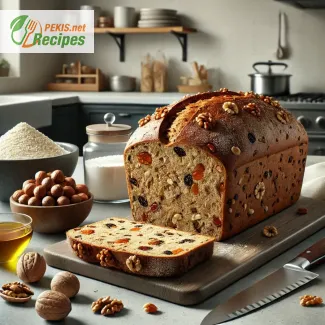
Discover the Tradition of Neapolitan Casatiello
A hearty Italian Easter bread rich in heritage, flavor, and rustic charm
Few dishes capture the essence of Southern Italian Easter traditions as authentically as Casatiello – a savory, ring-shaped bread from Naples, generously filled with cured meats, cheeses, and often adorned with whole eggs baked into its golden crust. This flavorful, festive bread is a staple of Neapolitan holiday tables, baked during Holy Week and shared among family and friends as a symbol of abundance, celebration, and faith.
Casatiello is not just a dish – it’s a culinary symbol woven into the cultural and spiritual fabric of Italian Easter festivities. Passed down through generations, this rustic bread speaks of ancient customs, deep-rooted Catholic symbolism, and a strong connection to both local ingredients and seasonal rituals. Its distinctive ring shape evokes the cycle of life and resurrection, while the eggs baked into the dough represent rebirth and renewal, making it the perfect offering for the Easter table.
Unlike its sweeter cousin Torta Pasqualina or the soft and fluffy Colomba di Pasqua, Casatiello is deeply savory and hearty, ideal as a centerpiece for Easter brunch or served sliced alongside antipasti. The dough, enriched with lard or olive oil, becomes tender and flavorful after hours of slow rising, while the fillings – traditionally salami, pancetta, provolone, and pecorino – melt slightly during baking, infusing the bread with an irresistible aroma and rich umami depth.
A celebration of southern Italian flavors and history
This Neapolitan masterpiece dates back to the 17th century, with some food historians tracing its roots even earlier. Traditionally, Casatiello was baked on Holy Saturday and served on Easter Sunday, symbolizing the end of Lent and the return to abundance after a season of fasting. The very name “Casatiello” is derived from “caso,” meaning cheese in the Neapolitan dialect – a nod to one of its most essential ingredients.
In Naples and surrounding regions, it is common to find families still preparing their own homemade Casatiello, often using secret blends of cheeses and meats that reflect regional preferences and family traditions. Some add black pepper, others tuck in olives or hard-boiled eggs, while others still swear by a combination of spicy soppressata and sharp pecorino for an extra punch of flavor.
Why Casatiello deserves a place at your Easter table
Beyond its cultural significance, Casatiello is a culinary experience in itself. The contrast between the soft, rich dough and the salty, savory fillings makes each bite unforgettable. Served warm or cold, it travels well, stores beautifully, and becomes even more flavorful the next day. It’s the kind of dish that evokes comfort, warmth, and nostalgia—a bread that tells a story with every slice.
Whether you're preparing it for a traditional Easter gathering, a weekend brunch, or simply to savor a bite of authentic Italian cooking, Casatiello offers an opportunity to reconnect with time-honored recipes and to honor a legacy of rustic, artisanal baking that has survived centuries.
An invitation to bake from the heart
What makes Casatiello so unique is its versatility and its deeply personal nature. While the base recipe remains the same, the fillings can be tailored to your taste, making each loaf a reflection of the baker’s own heritage and palate. It is not only delicious, but also deeply satisfying to make, inviting the baker to slow down and immerse themselves in a ritual that transcends simple nourishment.
In a time when convenience often overshadows tradition, baking Casatiello is a beautiful reminder of the joy found in slow, intentional cooking. From kneading the dough to layering in the rich fillings and weaving the decorative egg nests, every step is a chance to celebrate craftsmanship and the beauty of seasonal rituals.
As the golden crust emerges from the oven, its rich scent filling your kitchen, you’ll understand why this bread has remained a cherished Easter tradition for generations. Casatiello isn’t just food—it’s a memory in the making, a celebration of life, and a delicious link to the heart of Italian culinary heritage.i!
- Activate the yeast: In a small bowl, dissolve the fresh yeast (or dry yeast) and sugar in lukewarm water. Let it sit for 10 minutes until it becomes foamy.
- Prepare the dough: In a large mixing bowl, combine the flour and salt. Create a well in the center and add the yeast mixture. Start kneading the dough while gradually incorporating the melted lard (or substitute with softened butter or oil). Knead for about 10–12 minutes until the dough is smooth and elastic.
- First rise: Shape the dough into a ball, place it in a lightly greased bowl, cover with a clean towel, and let it rise in a warm place for about 90 minutes or until it doubles in size.
- Add the fillings: Once risen, transfer the dough to a lightly floured surface. Reserve a small piece of dough (about 100 g / 3.5 oz) for the decorative strips. Flatten the rest into a rectangle about 1.5 cm (½ inch) thick. Evenly spread the salami, pancetta, grated cheeses, and provolone cubes over the dough. Sprinkle with black pepper.
- Roll and shape: Roll the dough tightly into a log. Form the log into a ring shape and seal the ends together. Transfer the ring into a well-greased bundt or ring-shaped pan.
- Decorate with eggs: Press four whole eggs (uncooked, with shells) evenly around the top of the dough. Use the reserved dough to form thin strips and place them in a cross over each egg to secure them.
- Second rise: Cover the pan loosely and let the dough rise again for 45–60 minutes until puffy.
- Bake: Preheat the oven to 180°C (350°F). Beat the extra egg and brush the surface of the Casatiello. Bake for 55–60 minutes until golden brown and cooked through.
- Cool and serve: Let the bread cool in the pan for 15 minutes, then remove and cool completely on a wire rack before slicing.
Elevating the Flavor and Craft of Homemade Casatiello
Expert tips and creative variations to perfect your savory Neapolitan Easter bread
Casatiello is already a culinary masterpiece in its traditional form, but with a few thoughtful adjustments, it can become even more exciting and tailored to modern tastes or dietary preferences. Whether you want to intensify the flavor, improve the texture, or create a lighter and healthier version, there are numerous ways to refine this iconic Italian Easter bread while still respecting its roots. From ingredient upgrades to avoiding common pitfalls, mastering Casatiello at home allows you to personalize this festive bread and make it truly unforgettable.
How ingredient substitutions can transform flavor and texture
Changing a single ingredient in Casatiello can dramatically influence its taste profile and mouthfeel. One popular variation is replacing the traditional lard with high-quality extra virgin olive oil. This switch not only caters to those avoiding pork, but it also imparts a fruity, peppery undertone and produces a lighter crumb, making each bite less heavy while still flavorful.
For those who enjoy a more intense savory punch, try incorporating aged cheeses such as caciocavallo or aged Asiago alongside the standard pecorino. These cheeses add depth, saltiness, and complexity, enriching the bread's character. On the other hand, using a milder cheese like scamorza or low-moisture mozzarella can soften the intensity and create a more delicate balance between the dough and the fillings.
In terms of meats, spicy salami or soppressata adds a welcome heat that can offset the richness of the cheese, while herbed pancetta or prosciutto crudo introduces a nuanced aroma. Be cautious with very fatty or wet meats, which can make the dough soggy if not properly drained or partially pre-cooked.
Why homemade Casatiello is worth the extra effort
While store-bought versions may offer convenience, making Casatiello at home delivers a depth of flavor and freshness that simply can’t be replicated. You have full control over the quality of ingredients, the seasoning, and the baking process, allowing you to create a loaf that’s perfectly suited to your preferences.
Homemade bread also tends to have a better crust and crumb structure, especially when given ample time to rise. Slow fermentation enhances flavor development, creating a more aromatic and digestible bread. Additionally, baking at home lets you adjust the bake time and temperature to achieve a crisp exterior without drying out the interior.
Common mistakes and how to avoid them
Even experienced bakers can run into challenges when making Casatiello. One of the most frequent issues is under-proofing the dough, which results in a dense, gummy texture. Always allow the dough to rise until it has doubled in size, even if that takes longer than the recipe suggests.
Another mistake is overloading the dough with filling. While it's tempting to add extra meat and cheese, too much can lead to uneven baking and a greasy texture. Balance is key: ensure that the fillings are evenly distributed and in moderate quantities to avoid weighing down the dough.
Pay attention to the type of flour used. Traditional recipes call for Type 00 flour, known for its fine texture and gluten content, which contributes to a soft yet structured crumb. Substituting with all-purpose flour is possible, but may slightly alter the bread’s elasticity and final texture.
Health-conscious adaptations without losing authenticity
For a healthier twist, consider using a whole grain flour blend or semi-whole wheat flour, which increases the fiber content and adds a nutty flavor. While this does make the bread a bit denser, it also gives it a rustic quality that pairs well with smoky meats and sharp cheeses.
Reducing the amount of cheese or switching to low-fat versions can cut down on calories and saturated fat without significantly compromising taste. Plant-based alternatives to cheese and meats are also becoming increasingly available and can work well in this recipe, particularly when well-seasoned to mimic traditional flavors.
Replacing eggs on top with roasted vegetables like cherry tomatoes or thin zucchini ribbons can provide a pop of color and flavor while catering to those with egg allergies.
Seasonal and regional twists to inspire your version
Casatiello is deeply rooted in Neapolitan tradition, but that doesn't mean you can't take inspiration from other Italian regions. In southern Calabria, for example, chili flakes or 'nduja are added to give the bread a fiery kick. In the north, truffle-flavored cheese or speck may be used to offer a smoky elegance.
Adding a sprinkle of fennel seeds or rosemary to the dough gives a subtle herbal lift that pairs wonderfully with rich fillings. Sun-dried tomatoes, caramelized onions, or olives can also enhance the flavor complexity without overpowering the essence of the bread.
The importance of fermentation and baking techniques
A major part of perfecting Casatiello lies in how the dough is handled. Letting the dough ferment slowly in the fridge overnight creates a more complex, sourdough-like flavor and makes the final loaf easier to digest. This step also improves the overall texture, resulting in a lighter, airier crumb.
When it comes to baking, using a convection oven or placing a small tray of water in the oven for steam can help develop a crisp, evenly browned crust. Rotating the bread halfway through baking ensures an even bake, especially if your oven has hot spots.
If using a traditional ring mold, make sure it’s well-greased and dusted with flour to prevent sticking. Non-stick pans or even cast iron ring molds can enhance heat distribution and contribute to a better crust.
Making Casatiello your signature bread
Ultimately, the beauty of Casatiello lies in its adaptability and character. It invites bakers to respect tradition while adding their own signature. Whether you choose to go bold with spicy meats, lighten it with fresh herbs, or reimagine it for dietary needs, this bread always delivers warmth, nourishment, and a connection to Italian culinary heritage.
With care, precision, and creativity, you can transform this centuries-old Easter bread into a new family favorite, one that still honors its origins but brings something personal and unforgettable to the table.
Contains gluten, eggs, milk (lactose), and pork.
To make gluten-free: Substitute wheat flour with a gluten-free bread mix and adjust water quantity as needed.
To make egg-free: Remove the decorative eggs and egg wash; brush with plant-based milk instead.
To make dairy-free: Replace cheeses with lactose-free or plant-based cheese alternatives.
To make pork-free: Use poultry-based salami or vegetarian meat substitutes.
- Vitamin B12: 1.2 µg – supports red blood cell formation and nerve function
- Calcium: 220 mg – promotes bone health
- Phosphorus: 280 mg – supports energy metabolism
- Iron: 2.1 mg – helps oxygen transport in the blood
- Zinc: 2.4 mg – supports immune system
- Vitamin A: 150 µg – important for vision and skin
- Magnesium: 45 mg – supports muscle and nerve function
- Selenium: 20 µg – contributes to DNA protection and thyroid function
- Vitamin E: 1.4 mg – protects cells from oxidative stress
- Coenzyme Q10 (from pork): 1.2 mg – supports heart health and energy production





